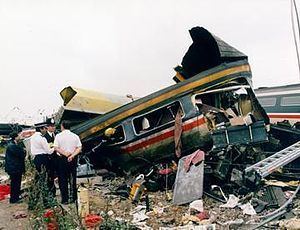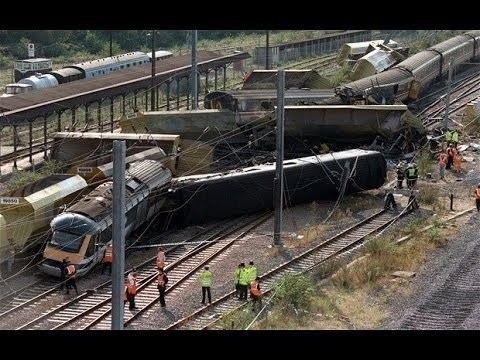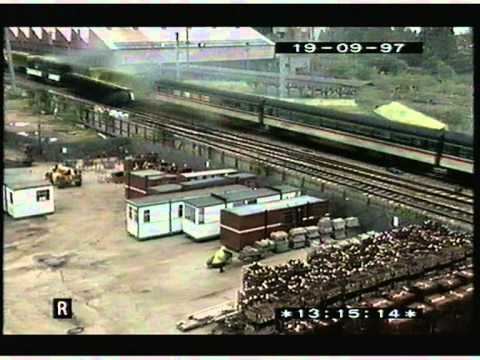Time 13:20 Trains 2 Date 19 September 1997 Operator Great Western Railway Passenger count 212 | Country England Passengers 212 Total number of deaths 7 Injuries 139 | |
 | ||
Similar Ladbroke Grove rail crash, Clapham Junction rail crash, Hatfield rail crash, Great Heck rail crash, Ealing rail crash | ||
Southall rail crash
The Southall rail crash was an accident on the British railway system that occurred on 19 September 1997, on the Great Western Main Line at Southall, west London, in which an InterCity 125 (also called a High Speed Train) failed to stop at a red (danger) signal and collided with a freight train crossing its path. The incident resulted in 7 deaths and 139 injuries. Great Western Trains were fined £1.5 million for violations of health and safety law in connection with the accident.
Contents

Incident

The crash occurred after the 10:32 Great Western Trains HST passenger train from Swansea to London Paddington, worked by power cars 43173 + 43163 and operating with a defective Automatic Warning System (AWS), passed a red (danger) signal (SPAD), preceded by two cautionary signals.
As the tracks straightened ahead of the HST train, the driver observed a Class 59 locomotive a mile in distance, moving "at a funny angle" and realised to his horror that it was crossing the Up Main line. The EWS-operated freight train was coming from London on the Down Relief line, hauling twenty empty bogie hopper wagons, and permitted to cross Southall East Junction on its way into Southall Yard, south of the main lines. A collision was now inevitable. The HST was travelling at 125 miles per hour (201 km/h), and could not stop in time even under full braking.
Alan Bricker, the driver of the freight locomotive No. 59101, observed the approaching HST and expected it to stop, but was alarmed at its speed and apparent brake application. In desperation, he tried to accelerate his train out of the path of the HST, but to no avail. The later accident report found that:
- 13:20 GMT, the front power car of the HST impacted with a 22 tonnes (24 tons) hopper car
- 2 seconds later, coach H impacted with a hopper. The HST power car severed the brake pipes of the freight train, causing the stranded rear hopper wagons to come to an immediate halt.
- 4 seconds into the accident, with the HST still travelling at 60 miles per hour (97 km/h), coach H impacted with a severed coupling from the freight train, and began to topple away from the freight train onto to its left side. It slid on its side for a further 4 seconds. 2 people died in this carriage.
- 8 seconds into the accident, with both the forward HST power car and coach H clear forward of the scene, coach G - the second coach in the HST formation - hit the now stationary rear of the freight train. The freight wagons were resultantly driven back and jacknifed.
- Both coach G and the impacted hopper wagon lifted into the air. Whilst the hopper wagon was restrained in its movement, colliding and jamming up against the nearby OLE stanchions, coach G slid under the hopper. This resultantly flattened the front of coach G.
- 10 seconds into the accident, the residual rear of the HST train led by coach F, impacted with the now stationary coach G. The resultant energy release of the still in-motion rear of the HST bent the structure of coach G into a distinct half-curve at its midpoint. As a result of its various actions, and almost complete destruction, 5 people died in coach G.
- The rear of the HST, led by coach F, impacted with the stationary rear of the freight train. Coach F was left derailed.
Six people were killed, and a seventh passenger died in hospital.
If the AWS equipment on the High Speed Train (HST) passenger train had been working, the chance of the accident occurring would have been highly unlikely, though not completely eliminated, since the AWS is only an advisory system. The driver's attention had been distracted (though no proof was ever discovered) and he did not observe the preceding signals visually, but AWS would have given him a clear audible warning, which would have required him to acknowledge the warning. Failure to acknowledge the warning would have caused the train's brakes to be applied. Automatic Train Protection (ATP) equipment would have almost certainly prevented the accident. The train was fitted with ATP but this was switched off. At the time of the accident, the ATP equipment was not required to be switched on, as it had proved troublesome in service. In addition, not all drivers had been trained on it.
Aftermath
Following this accident and the Ladbroke Grove rail crash, the train operating company First Great Western now requires all its trains to have ATP switched on. If the equipment is faulty the train is taken out of service.
The passenger train driver, Larry Harrison, was initially charged with manslaughter, but the case was dropped. His employer, Great Western Trains, was fined £1.5 million for not having a system to ensure High Speed Trains were not operated for long journeys with AWS inoperative.
The action of the signaller in stopping a high speed passenger train to allow a slow freight train to cross in front of it has been criticised. However, this is standard procedure when regulating trains to minimise overall delay; there was no reason for the signaller to expect that the HST driver would not stop at his red signal. At the time there was no requirement for the signaller to have been informed that the HST was in service with its AWS isolated. The rulebook was altered to cover this;
"Driver.....if you become aware that the AWS has become defective when it is required to be in operation, you must.....tell the signaller"
The key point identified in the report was that drivers had become increasingly reliant on AWS with single-manning and high speeds, and that it was no longer acceptable to run trains at full speed if the equipment was inoperative. The rulebook was changed, so that if AWS is isolated the train may only run at high speed with a competent person accompanying the driver in the cab. This person must have full knowledge of the route and know how to stop the train;
"If a competent person is provided....proceed at normal permissible speed to the location where the train can be dealt with. During poor visibility, the train speed must not exceed 40 mph (65 km/h)"
or
notPower car 43173 was written off and scrapped at Pig's Bay, having sustained heavy damage during the accident.
